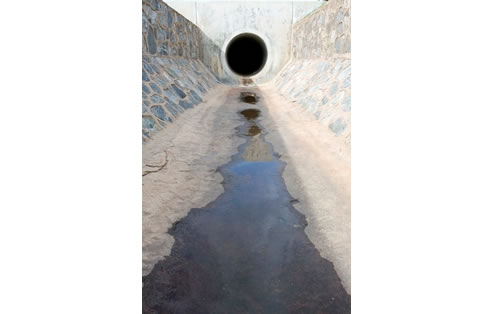NEWS ARTICLE ARCHIVESConcrete Pipes and Water Pollution from Think Pipes Think PVC The challenge for those within the urban water profession is both to protect both water quality and the ecological health of urban waterways (Aplin 2002)¹. Several studies and reports have concluded that concrete pipes have a greater negative effect on water chemistry than PVC Pipes for certain chemical attributes. It is commonly known as the urban stream syndrome, where the streams and rivers are being polluted not just from the waste that is being carried in the water, but by the concrete pipes and pipeline infrastructure carrying the water. A common factor that contributes is contamination from sewage which seeps into the waterways via cracked concrete pipes and joints, termed "exfiltration". This escapee sewage can constantly flow into soil and local streams. The contamination of the waterways by exfiltration changes the chemical make-up of the waterways. Studies have established that the degree of impervious surfaces in urban areas is closely related to the degree of degradation of freshwater stream ecosystems. A 2011 study titled A New type of water pollution : concrete drainage infrastructure and geochemical contamination of urban waters², concluded that: "The use of concrete particularly its application for urban drainage is responsible for some of the modifications to urban stream geochemistry. Thus, urban geology should be considered as an important factor that contributes to the urban stream syndrome" Ian Wright, Lecturer in Environmental Science at University of Western Sydney has a particular interest in pollution ecology and the use of freshwater fauna as pollution indicators. He explained to EcosMagazine.com the effects that contamination is having on urban water streams in a 2011 article. "While concrete contamination alone may not be a critical threat in urban streams that flow in catchments with a natural limestone geology, our findings suggest that in some situations, concrete contamination may be contributing to urban stream syndrome. For example, recent data from the Georges River catchment, south-west of Sydney, reveals that urban streams are ecologically very sick. The bicarbonate (alkalinity) levels in the most highly urbanised catchment streams are more than 40 times higher than the 'natural' levels typically recorded in Georges River bushland catchment streams. In this situation at least, it is likely that urban concrete stormwater infrastructure is having a constant degrading effect on urban streams." ¹ Aplin, Graeme 2002, Heritage identification, conservation, and management, Oxford University Press, Melbourne. ² Walsh, C.J., Sharpe, A.K., Breen, P.F., and Sonneman, J.A. (2001). Effects of urbanisation on streams of the Melbourne region, Victoria, Australia. I. Benthic macroinvertebrate communities. Freshwater Biology 46, 535-551 |
 |
 |